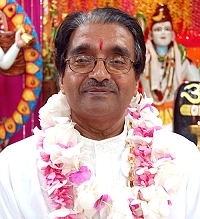From New Year’s satsang with the Paramacharya of SWAHA, Pt. Hardeo Persad
I wish you all the best for the new year. As we continue on our spiritual journey, this service will be geared towards helping us based on the circumstances to which we have been exposed for almost two years. In life, we are often faced with challenges. How do we confront these challenges successfully? We pray and worship the Divine. God takes care of everything in our lives only when we surrender unconditionally to Him, the state of sharanaagati. However, very few people have achieved this state; and when challenges occur, we still question and doubt God. The practical solution is, as the Dalai Lama is attributed as saying, “I believe in God, but I lock my car door.” For instance, within our present situation of the COVID-19 pandemic, we are confronted with new variables such as vaccination, masking and various health protocols. In this context, it is only reasonable that we should take the necessary precautions while still engaging in worship and devotion to God. We must remember that everything in life is temporary and even COVID-19 will one day end and be replaced by other challenges.
Furthermore, just as we take important steps to prepare for any physical illnesses that may face us this year, we should also strengthen ourselves to deal with any mental illnesses that might arise, such as depression, or our ability to cope with challenging circumstances. If we develop the right qualities and strengths in ourselves, we can transcend any challenges. We must be mentally strong, determined and take each moment as it occurs and always remain in the light of hope. We must surrender to God, in whatever form we conceive His Divinity to be. Moreover, we must be proactive in our duties, our prayers and our spiritual growth.
There is an important episode in the Ramaayan, where Shree Raam explains to his true devotee and friend, Vibheeshan, that his chariot was not a traditional, physical one with two wheels, horses, a charioteer, a banner and an ensign. He explained the deeply symbolic chariot, which can be used to destroy all enemies in the battle of life. The two wheels of the chariot are courage and bravery. They are akin to Devi Maa, the representation of willpower and determination that permits us to succeed in life. Truth and good conduct, as prescribed by religious scriptures, are the banner and ensign of the chariot. The four horses that pull the chariot forward represent: bal, physical strength, which we gain through good nutrition, exercise and rest; vivek, discriminative power or the ability to differentiate truth from untruth; dum, self-control, specifically referring to the five senses, the gyaan indriyas: sight, hearing, smell, taste and touch; and the fourth is parohit, service to society, which is service to God. The senses of perception are similar to the horses, which might pull the chariot in different directions; they must be reined in so that the chariot can move forward with stability. The three reins for controlling the four horses are: kshamaa or patience, kripaa or grace, and samhitaa or even mindedness.
The charioteer is the attitude of constantly seeking God. If we perform all our actions as an offering to the Divine, with our minds constantly fixed on Him, our life becomes a puja. Life is but an empty dream unless we realise that Supreme Being. The shield which shelters us from harm is spiritual dispassion, vairaagya, the ability to let go, symbolised by Bhagavan Shankar. The sword is contentment, santosh. Daan parashu, is the battle axe, the quality of charity and giving of gifts. The spear is enlightened intellect, buddhi. In other words, we must be able to raise our intellect above the mundane considerations of materialism and advance to a more spiritual level. The bow is vigyaan, the knowledge of the immediate self in relation to the Super Self. It will help us to overcome all internal negativities in order to realize the ultimate objective, Aham Brahmasmi, the Lord and I are one.
The quiver of arrows is amal, a mind without impurities, an unwavering mind, and the ten forms of self-restraint (ahimsa or non-injury, satya or truthfulness, asteya or non-stealing, brahmacharya or chastity, kshamaa or patience, dhriti or steadfastness, dayaa or compassion, arjava or honesty, mitahara or moderate diet and saucha or purity). There are also 10 arrows in the form of positive virtues (hri or modesty, santosh or contentment, daan or charity, astikya or faith, ishvarapujana or worship of the Lord, siddhanta sravanam or scriptural listening, mati or self-study, vrat or sacred vows, jap or mantra recital, and tapas or austerity). The worship of genuine holy ones is also considered an impenetrable armour that can shield one from any attack. Any devotees who possess such a chariot, armour and weapons cannot be defeated in this world. Such devotees will be able to transcend and overcome any challenges that confront them and will advance in spiritual growth. Keep the journey going, focus and put God in front. Remember, He makes the difference. Blessings to each and every one of you and all the best for the new year.




Dularie Chotoo
It’s always a Divine pleasure , to listen